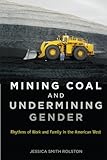Mining Coal and Undermining Gender : Rhythms of Work and Family in the American West / Jessica Smith Rolston.
Material type: TextPublisher: New Brunswick, NJ : Rutgers University Press, [2014]Copyright date: ©2014Description: 1 online resource (250 p.) : 4 photographsContent type:
TextPublisher: New Brunswick, NJ : Rutgers University Press, [2014]Copyright date: ©2014Description: 1 online resource (250 p.) : 4 photographsContent type: - 9780813563688
- 9780813563695
- 331.4/82233409787 23
- HD6073.M62 U676 2014
- HD6073.M62 U676 2014eb
- online - DeGruyter
- Issued also in print.
| Item type | Current library | Call number | URL | Status | Notes | Barcode | |
|---|---|---|---|---|---|---|---|
 eBook
eBook
|
Biblioteca "Angelicum" Pont. Univ. S.Tommaso d'Aquino Nuvola online | online - DeGruyter (Browse shelf(Opens below)) | Online access | Not for loan (Accesso limitato) | Accesso per gli utenti autorizzati / Access for authorized users | (dgr)9780813563695 |
Frontmatter -- Contents -- Preface and Acknowledgments -- Part I. Orientation -- 1. Putting Kinship to Work -- 2. Labor Relations and Corporate Social Responsibility -- Part II. Putting in Time -- 3. Shiftwork as Kinwork -- 4. Interweaving Love and Labor -- Part III. Undoing Gender at Work -- 5. Tomboys and Softies -- 6. Hard Work, Humor, and Harassment -- 7. Conclusion -- Notes -- Glossary of Mining Terms -- References -- Index -- About the Author
restricted access online access with authorization star
http://purl.org/coar/access_right/c_16ec
Though mining is an infamously masculine industry, women make up 20 percent of all production crews in Wyoming's Powder River Basin-the largest coal-producing region in the United States. How do these women fit into a working culture supposedly hostile to females? This is what anthropologist Jessica Smith Rolston, herself a onetime mine worker and the daughter of a miner, set out to discover. Her answers, based on years of participant-observation in four mines and extensive interviews with miners, managers, engineers, and the families of mine employees, offer a rich and surprising view of the working "families" that miners construct. In this picture, gender roles are not nearly as straightforward-or as straitened-as stereotypes suggest. Gender is far from the primary concern of coworkers in crews. Far more important, Rolston finds, is protecting the safety of the entire crew and finding a way to treat each other well despite the stresses of their jobs. These miners share the burden of rotating shift work-continually switching between twelve-hour day and night shifts-which deprives them of the daily rhythms of a typical home, from morning breakfasts to bedtime stories. Rolston identifies the mine workers' response to these shared challenges as a new sort of constructed kinship that both challenges and reproduces gender roles in their everyday working and family lives. Crews' expectations for coworkers to treat one another like family and to adopt an "agricultural" work ethic tend to minimize gender differences. And yet, these differences remain tenacious in the equation of masculinity with technical expertise, and of femininity with household responsibilities. For Rolston, such lingering areas of inequality highlight the importance of structural constraints that flout a common impulse among men and women to neutralize the significance of gender, at home and in the workplace. At a time when the Appalachian region continues to dominate discussion of mining culture, this book provides a very different and unexpected view-of how miners live and work together, and of how their lives and work reconfigure ideas of gender and kinship.
Issued also in print.
Mode of access: Internet via World Wide Web.
In English.
Description based on online resource; title from PDF title page (publisher's Web site, viewed 30. Aug 2021)


